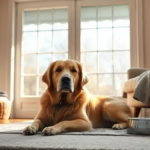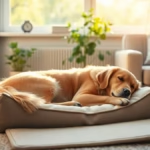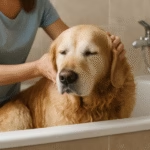I know small changes can feel huge. I watch for stiffness, limping, and slower walks. I weigh my dog and note eating habits each week. I check for cloudy eyes, hearing loss, and gum redness. I add ramps, non-slip floors, gentle play, and joint supplements. I keep a simple log to share with my vet and to keep my dog comfortable.
Key Takeaway
- My dog moves slower and has trouble with stairs.
- Gray fur appears around the muzzle and eyes.
- He sleeps more and plays less.
- Joints stiffen or he limps after resting.
- Eating, drinking, or bathroom habits can change.
How I Spot Mobility Problems and Golden Retriever Arthritis Symptoms
I started paying attention when my Golden slowed down and stretched like an old man waking from a chair. I learned the first signs of aging in Golden Retrievers by watching small shifts: hesitance on the stairs, longer naps, and a change in the way he sat. Those tiny changes often show up before a full limp.
Emotion hits you first. One day he refused the couch jump he’d done a hundred times. I felt guilty and worried, so I began logging moments instead of guessing. Writing down when he stiffened, how long it took him to stand, and whether one leg looked weaker gave me clear clues to share with the vet.
Over time I connected patterns—morning stiffness that loosened with movement, limping after play, or a change in stride all pointed toward arthritis. Photos and short videos proved the pattern and made vet conversations calmer and more focused; having that footage has been useful during veterinary visits.
Stiffness, limping, and slower walks I watch for
Morning stiffness is the first bell for me. He would stand slowly, hold a leg up, or shake it like someone rubbing a sore knee. If he warmed up after a few minutes, I noted that. If stiffness stayed, I cut walks short that day.
Limping can be subtle—a shorter step on one hind leg for a week, then gone, or favoring a paw after running. I watch for pace changes, reluctance to climb, or longer rests on walks. Those shifts tell me when to rest him, call the vet, or stop rough play. For comfort and mobility support I learned options for managing arthritis and joint care.
| Sign | What I saw | What I did |
|---|---|---|
| Morning stiffness | Slow to stand, holds a leg up | Shorter walks, gentle massage, note time/duration |
| Limping after activity | Shorter steps or favoring a leg | Rest day, photo/video, vet consult if persistent |
| Slower walks | Slower pace, frequent rests | Track distance/time, adjust routine, add soft bedding |
How I track movement changes to tell my vet
I keep a simple log on my phone: date, time, what happened, and a short note like stiff 2 min after waking or limped 5 steps then fine. A 30-second video is gold during vet visits because it shows the issue plainly and speeds up diagnosis during veterinary consultations.
I measure repeatable things: walk length in minutes, number of stairs, and how many times he sat during a walk. Small numbers make a big difference when the vet asks, How much did it change? Tracking these repeatable measures pairs well with practical advice for mobility issues.
What I Notice About Aging Golden Retriever Weight Loss and Appetite Changes
I watch my old Golden like a weather vane. Some weeks his appetite is steady, other weeks he eats like a sparrow. Weight loss in seniors can sneak up; I learned to read small shifts in his rib line, energy, and enthusiasm for meals. I compare what I see to lists like the first signs of aging so I don’t ignore little changes.
When his bowl sits full more than usual, I worry. With age, teeth can hurt, digestion slows, and the joy of food can fade—issues my vet has helped with during routine dental and health checks. A dog who used to clear the plate might nibble or turn away—that pattern tells me something is off. I write down how much he eats and his behavior after meals.
I notice how weight loss ties to other signs: quieter walks, more naps, stiffer joints. Weight loss without lower activity is a red flag and can point to internal issues like kidney changes, so I don’t wait to investigate; I compare notes with guides on how to recognize kidney problems when needed.
How I weigh my dog and note eating habits every week
I weigh him once a week at the same time, usually after a morning walk and before breakfast. I use the bathroom scale trick: step on, pick him up, step on again, and subtract. For heavier or anxious dogs I use the vet or groomer scale. I record the number in a notebook or my phone, plus what and how much he ate. This routine supports advice on how to maintain an ideal weight.
- Pick a consistent day and time.
- Use the same scale each week.
- Note weight, meal size, mood, vomiting or diarrhea.
- Track treats and appetite changes.
This routine felt odd at first, but it became a habit that gave me peace of mind and a factual record for the vet.
When I contact the vet about sudden weight loss or poor appetite
If he loses noticeable weight in a couple of weeks, or refuses food for more than two meals, I call the vet. Other urgent signs: repeated vomiting, blood in stool, trouble breathing, or sudden lethargy. I learned not to wait for a dramatic collapse—early calls help the vet help him faster.
I bring my notes. He seems off is less useful than three weeks of numbers and observations. That record often leads to quicker tests and treatment as part of essential veterinary care.
| Sign I See | Action I Take |
|---|---|
| Gradual weight drop over weeks | Call vet for bloodwork and appetite review |
| Refuses food for 48 hours | Phone vet same day |
| Vomiting, bloody stool, collapse | Emergency visit |
| Eats but loses weight | Ask about dental issues, parasites, organ tests |
Diet tweaks and senior dog nutrition tips I tried
I warmed his food, added low-sodium chicken broth, mixed in soft wet food, and tried a senior formula with more protein and joint support after vet approval—based on recommendations in senior nutrition guides. Small, frequent meals and tasty toppers helped. Probiotics and omega-3s made a subtle difference; I introduced supplements only after discussing them with my vet and checking recommended options.
How I Recognize Senior Dog Vision and Hearing Loss — Common Signs of Aging in Senior Golden Retrievers Owners Should Notice
He started missing the toy toss he used to catch and took longer to find me when I called. Those small changes were the first hard clues his eyes and ears were slipping—things explained well in a guide to vision problems in aging Goldens and tips on managing hearing decline.
He bumped into the coffee table once or twice, hesitated before stairs, and paused during games he loved. At night he woke more often and seemed confused by the dark. Those moments told me to act before he hurt himself, and that my home needed small changes to keep him safe—ideas in how to adapt your home for a senior Golden.
Once I accepted the change, I did simple tests and routine checks at home. Reading subtle signs—a dull eye shine or blank stares at sound—made life easier and safer.
Simple checks I do for sight and ear decline at home
I try quick sight checks every few days: watch how he follows a toy or my hand, toss a soft toy from the side and above to see if he tracks it, note hesitation at familiar steps, and photograph eyes to compare over time.
- Call his name from another room, then clap once and use a distinct sound (metal bowl, squeaker). Watch for head turn.
- Hold a toy at different heights and angles to test tracking.
- Shine a soft light briefly to see a blink or pupil response.
- Roll a ball across the floor to check motion tracking.
- Inspect ears for wax, odor, or swelling and consult resources on hearing care.
These simple steps take minutes and give clear signs to share with the vet.
Behavior clues I saw that pointed to vision and hearing loss
He became quieter and more clingy, then more cautious. He stopped answering when I whistled, barked at empty rooms, or froze mid-walk. Slow tail wags, closed-mouth panting, and a tucked posture told me he felt unsure. Reading that body language helped me change our routine to calm him; see more on behavioral changes in aging dogs.
Safety changes and clear routines I put in place
I added soft night lights, non-slip runners on stairs, and kept furniture in the same spots so he could map the house by touch and scent. I used a gentle touch cue before approaching and a single-word command for direction. Meals, walks, and play stayed on a steady schedule. Small changes—raised bed, easy ramps, and scent games—kept him safe without taking away his joy; see ideas in mental enrichment activities and home adaptations in home adaptation guides.
How I Keep Up With Dental Issues in Senior Golden Retrievers
I watch his mouth daily when he yawns or is calm, and I smell for bad breath. Dental trouble often shows as changes in eating, chewing, or mood, so I note anything off, take a photo, and show the vet a timeline.
| Sign I see | What I do right away |
|---|---|
| Bad breath or drooling | Photo, gentle brushing, schedule vet check if persistent |
| Red or swollen gums | Inspect daily, offer soft food, call vet if bleeding or pain |
| Broken, loose, or missing teeth | Soft diet, avoid hard toys, book vet visit |
My daily checks are quick: mouth inspection during petting, soft treats that don’t stress teeth, and a nightly tooth rub. I move slowly, praise him, and keep him calm during checks.
Gum redness, bad breath, and broken teeth I look for
Gums should be pale pink. Red or dark gums worry me about infection. Bad breath that doesn’t improve often means bacteria. Broken or loose teeth can show up as a refusal to play. When I see signs, I switch to soft food, photograph the mouth, and call the vet for guidance as part of essential veterinary care.
How I plan vet cleanings and at-home tooth care
We schedule cleanings per the vet’s advice—annual checks or every six months if needed. Before each cleaning I confirm the anesthesia plan and pain control, tell the vet about current meds, and follow pre-op instructions.
- Call vet to book and describe mouth issues.
- Follow pre-op instructions.
- Arrange pick-up and comfort items for after surgery.
- Ask for a post-cleaning care plan and any home meds.
After visits I write down the vet’s notes and follow-up steps so nothing slips through. I pair this with daily comfort steps from daily comfort routines.
Gentle brushing and vet-approved chews I use
I brush gently with a soft-bristled dog brush and vet-approved enzyme toothpaste—just a few strokes until he’s used to it. For chews, I pick vet-approved dental sticks made for seniors—soft enough not to crack a tooth, firm enough to help clean.
How I Handle Senior Golden Retriever Behavior Changes and Cognitive Signs
I watch for small shifts: slower turns, longer naps, blank stares at familiar toys. I note them and share with the vet—turning vague worries into facts we can act on.
I changed the house to fit him: non-slip rugs, a lower bed, and a quiet corner with soft light. I adjusted meals and walks to match his energy. These changes cut stress and made daily life easier.
I learned to be gentle with expectations—shorter, softer play sessions and praise for tiny wins. That attitude made him happier and care feel like teamwork.
Confusion, sleep shifts, and anxiety I learned to spot
He paced at night, stared at walls, or forgot where the door was. Once he bumped into a chair he’d always navigated fine; that told me his brain and body were changing. I treated those signs as signals, not chapter endings. I added a night light, moved his bed closer, and took him out before I went to sleep. I also discussed pain and thyroid checks with the vet because medical issues can mimic confusion; resources on canine dementia and signs of pain helped me decide next steps.
| Sign I saw | Small change I made |
|---|---|
| Pacing at night | Night light and a short walk before bed |
| Getting stuck in corners | Clear paths and low furniture |
| Forgetting commands | Short, easy training sessions and more praise |
Ways I calm my dog with routines and patience
Routines became my secret sauce—same wake-up, feed, and walk times gave him a clock to trust. Predictability soothed his anxiety more than treats. If he had a bad night, I didn’t punish; I sat with him, stroked his fur, and used a calm voice.
- Keep a calm routine: same times for walks and meals, short play sessions, quiet evenings.
Short training sessions and predictable schedules I added
I switched to five- to ten-minute training bursts focused on easy tasks: eye contact, a gentle sit, or tapping a target. Short sessions give quick wins. I repeated them twice a day and mixed in scent games to keep his mind active without tiring him; see gentle training tips and mental enrichment ideas.
How I Enrich My Aging Golden Retriever’s Life and Improve Senior Dog Care
I started small the day I noticed him slowing. I changed walks, watched his joints, and learned what helped him feel like himself. I talk to the vet often, watch his weight, and adjust routines when he seems tired. Little changes made a big difference.
I keep a close eye for signs of aging—stiff joints after sleep, quieter play, or slower stairs—and act fast: more rest, gentle exercise, and sometimes supplements after vet approval. Catching things early kept him comfortable longer.
Emotion matters as much as medicine. I soothe him with massages, talk in a calm voice, and let him sleep near me when nights are hard. My goal is dignity and joy in his golden years. Small rituals—peanut-butter puzzles and a short cuddle—became favorites.
Low-impact exercise and joint-friendly play I do each day
I limit long runs and swap them for slow walks and short swims. Water lets him move without weight on his hips; we followed guidance on hydrotherapy when trying pool sessions. I do gentle range-of-motion exercises: slow leg lifts, mild hip stretches, and short sit-to-stand reps, informed by resources on canine physical therapy. I never push—must stop when he shows fatigue.
My daily routine:
- 10–15 minute warm-up walk on soft ground
- 5–10 minutes of low-impact play or shallow pool time
- 5 minutes of slow massage and range-of-motion work
- Short rest, then a brief evening potty walk
Home fixes like non-slip floors and raised beds I made for comfort
I replaced slick rugs, added runners so he stops sliding, installed a short ramp to the couch and a wide ramp to the back seat. I raised his bowls and put an orthopedic bed by the heater. Night lights by stairs and baby gates kept him from risky steps. These small fixes reduced stress for both of us—see tips on adapting your home and choosing the right bed.
Toys, supplements, and vet advice that helped my dog
I kept toys soft and mentally stimulating: plush puzzles, slow-dispense Kongs, and scent games. My vet recommended omega-3s and glucosamine/chondroitin; we added them slowly and watched for improvement, following guidance on safe supplements. Pain control and bloodwork are regular check-ins—my vet adjusts meds when inflammation flares and checks labs as detailed in essential veterinary care and pain identification guides.
| Item | Why I used it | My notes |
|---|---|---|
| Soft puzzle toys | Keeps his brain active without running | He loves peanut butter Kongs at nap time — see mental enrichment |
| Omega-3 (fish oil) | Reduces inflammation and supports coat | 4–6 weeks for shinier fur — check supplement guidance |
| Glucosamine chondroitin | Supports joint comfort | Helped him stand easier after a month — see joint care strategies at arthritis comfort |
| Vet check-ups & bloodwork | Catch issues early and adjust meds | Regular checks caught a minor kidney change early — part of essential care |
Quick Checklist — Common Signs of Aging in Senior Golden Retrievers Owners Should Notice
- Stiffness or limping after rest
- Shorter, slower walks or reluctance on stairs
- Noticeable weight loss or appetite change — see weight guidance
- Cloudy eyes, bumping into objects, or changed night behavior — read about vision problems
- Less response to name or calls, or startle to sound changes — learn about hearing loss
- Bad breath, red/swollen gums, broken or missing teeth — book a check via veterinary care
- Confusion, pacing at night, or forgetting commands — see cognitive decline signs
If you spot these signs, document them—dates, videos, weights—and call your vet. Early action helps.
Conclusion
Watching a senior Golden is like reading a slow, gentle book—the small lines matter. I pay attention to stiffness, weight, appetite, vision, hearing, teeth, and behavior, and I write it all down. Those little notes become my map when I talk to the vet.
When I act early—shorter walks, soft beds, ramps, gentle play, supplements after a check-up—I give him comfort and dignity. Routine is my secret sauce: predictable meals, short exercises, and clear cues calm him more than any quick fix.
I don’t have all the answers. I ask questions, take photos and videos, and choose gentle care over rushed solutions. Small changes add up and buy us better days. If this helped you even a little, read more practical tips and stories at building stronger bonds with your senior Golden.

Rafael Souza is a digital marketing strategist and lifelong dog enthusiast. Passionate about Golden Retrievers, he shares practical, research-based tips to help owners provide healthier and happier lives for their furry companions.





